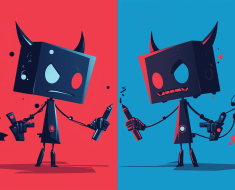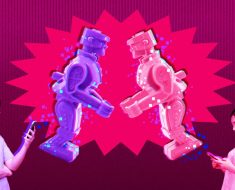AI has incredible potential for content creation. It’s fast, intelligent, and learned from some of the best human artists, writers, and creators out there. If used responsibly and ethically, AI can help us achieve a lot in a short time.
However, there is a stigma towards AI content. A lot of people aren’t happy with the idea of AI replacing humans. Experts have assured the public time and again that their fears are exaggerated but many remain unconvinced. So, if there’s even the slightest hint of robotic origins, the content is rejected.
It doesn’t help that AI writing is often robotic, long-winded, and monotonous, either.
But, to play the devil’s advocate, some of the fear is justifiable. Some companies have questionable learning sets that may or may not have been stolen, writers and artists have been laid off because of AI despite their expertise, and there’s also the fact that AI has a lot of potential for misuse in universities and the workplace.
So, if you’re a writer and you want to use AI to make your life easier, here are the best (and most ethical) ways of making AI write similar to you:
Make AI Avoid Participle Phrases
LLMs have a tendency to add a participle phrase after the main clause, often to identify or to reveal a cause or a reaction. For example, here’s an excerpt from an essay written by ChatGPT:


In just those three paragraphs, I can identify at least three participle phrases:
- “Established in 1993 by the Maastricht Treaty, the EU evolved from earlier cooperation efforts such as the European Economic Community (EEC), founded in 1957.”
- “The EU has created a single market allowing for the free movement of goods, services, capital, and people between member states, fostering economic growth and opportunities.”
- “On the international stage, the EU is a significant player in trade negotiations and foreign policy, working to maintain peaceful relationships and offer humanitarian aid.”
This is highly identifiable both by people and AI detectors as machine-generated. As proof:


By switching up the sentence structure, you can easily make your text sound more human. For example, instead of my last example above, I can easily just say: “The EU is a significant player in trade negotiations and foreign policy on the international stage. It works to maintain peaceful relationships and offer humanitarian aid.”
But doing it on your own is time consuming, so I suggest asking your chatbot to avoid using them instead. Here’s the new essay generated by ChatGPT using those instructions:


And as proof that it’s more humanized, here’s its new AI detection score:


72.1% — a lot lower, but we can do better. Let’s try using an AI bypassing tool (Undetectable AI, we’ll get to it later) along with this new output. If everything goes according to plan, the final version should have a near-zero AI likelihood score.


Turns out, I was right:


Ask LLMs to Remove Repetitions and Lists
LLMs also tend to list examples, but it manifests in different ways. ChatGPT and Claude often use in-sentence lists. The essay above has one such phrase: “goods, services, capital, and people between member states.”
Gemini, on the other hand, have a preference towards bullet lists.


Here’s the truth: examples are a good way to establish trust between a writer and a reader. But most times, two examples would suffice. You don’t need a list for everything. This just leaves you with less room to show your creativity since the bulk of your essay is just enumerating stuff.
When making AI text more human, I highly recommend limiting lists. Let’s put this to the test.
Here is the AI likelihood score of the output I’ve shown you above:


Now, let’s ask Gemini to tweak the prompt by turning it into paragraph form and limiting lists. Let’s also make sure to follow our own advice above and make Gemini avoid using participle phrases.


So, what’s the AI likelihood score now?


Remove Common AI Words and Phrases
I’m going to show you two essays (about completely different topics) I’ve generated using ChatGPT.
|
The American Revolution was a pivotal event that reshaped the course of history. As colonists sought independence from British rule, they delved into the ideals of liberty, equality, and governance. Leaders like George Washington and Thomas Jefferson utilized the power of rhetoric and military strategy to revolutionize their nation’s future. This movement wasn’t just about freedom from oppressive taxes or unfair laws—it symbolized a larger fight for self-determination. By breaking free, the revolutionaries inspired future generations to delve into the concept of democratic governance, proving that collective action can indeed revolutionize societal structures. The tactics and principles utilized during this period laid the groundwork for a new world order, with its ripples still felt today in global struggles for independence and rights. |
Maximalism is an artistic and cultural movement that embraces excess, complexity, and boldness. Artists and designers delve into intricate details, utilizing vibrant colors, textures, and patterns to revolutionize conventional norms of aesthetic minimalism. Unlike minimalism’s “less is more” approach, maximalism celebrates an abundance of ideas and visuals, pushing the boundaries of creativity. This movement often layers meaning and symbolism, encouraging the viewer to delve deeper into the artwork. By utilizing this approach, maximalist creators revolutionize the way people experience art, inviting them to engage fully with the overwhelming richness. Through its audacity, maximalism has transformed not only design but also lifestyles, challenging people to break away from simplicity and embrace the beauty of complexity and excess in everyday life. |
Notice how some words appeared in both essays? For example: delve, utilize, and revolutionize.
LLMs have a tendency to overuse some words, and this problem isn’t limited to ChatGPT only. The reason behind this is that AI doesn’t actually think (at least, not yet) but they work on patterns. The best way I could describe it is the autofill on your phone when you’re sending a message. ChatGPT, Claude, and Gemini all work like that.


Midjourney
Humanizing AI text starts with limiting these words. Some of them are the ones I mentioned earlier, along with symbolize, establish, vital, fostering, primary, and more. LLMs also rely on transitional words more than humans do.
Just to be clear: by no means am I saying not to use these words, but using them sparingly.
Prompt Engineering
There’s two ways of adding a personal touch to an AI’s essay.
The first one is what I recommend, but it’s also the more time-consuming way. You should always try to add your own section to an LLM’s output. This could be in the form of an anecdote or opinion. Sure, you’re still going to write this way — but honestly, you’ve saved a lot of time using AI, so what’s five to ten minutes of extra words?
The other way is to prompt engineer. This involves adding more information to the prompt like tone, inclusions and exclusions, and intent. You could also give it some of your old writing samples and ask it to write like you. This method also ensures less AI hallucination since you’ve provided all the information yourself.
Let’s try it.
Here’s an essay generated by ChatGPT about the Bronze Age collapse using a simple prompt.


It’s good, but boring. Not to mention that it will result to a high AI likelihood score:


So, what if we can make the prompt better? Here’s a template I like to follow:
|
Hi, ChatGPT. Pretend you’re a university student. Write an essay in under XX words. Don’t use too many transition words, instead rely on having a smooth flow. Here’s everything you need: – Topic: [Insert topic here] – Conclusion: [Insert conclusion and own thoughts here] – Tone: [Insert tone here] – Subtopics: [Insert talking points here] – Information: [Insert supporting information here] – POV: First person. |
Hi, ChatGPT. Pretend you’re a university student. Write an essay in under 200 words. Don’t use too many transition words, instead rely on having a smooth flow. Here’s everything you need: – Topic: WHY CAUSED THE BRONZE AGE COLLAPSE? – Conclusion: Inconclusive, but provide as many possible reasons why. – Tone: Serious. – Subtopics: How might the loss of trade networks and resources during the Bronze Age collapse have impacted daily life if similar events occurred today? – Information: – Information: >Interdependence: Bronze Age societies were highly interdependent, relying on trade for essential goods and resources. |


Now it’s waaaay better. It also should have a lower AI likelihood score too:


Use Undetectable AI
And lastly, we have AI humanizers. These are AI paraphrasing tools that humanize your text by removing telltale signs that they come from LLMs. You can choose between HideMyAI, Netus, WriteHuman, etc.
But my most recommended is Undetectable AI. Apart from its paraphrasing tool, this platform also offers output customization features that make sure the tweaked version of your input matches your tone and intent.
We’ve tested this before against AI detection tools and other AI bypassers. It works quite well. Here is our full review of the platform.
But here’s a sneak peek of it in action. Here’s an essay generated by ChatGPT and its AI likelihood score from Sapling, a reliable AI detector.




Not great. With Undetectable AI, that number goes down to…




14.6%. That’s low enough that you can argue this text is more human than it is AI (even though it is).
The Bottom Line
It’s probably a bit overused by now, but this is still true:
No AI writing can replace actual writing by a person.
We just have so much more to offer than LLMs. There’s no machine out there that can be as creative as humans. We’re better writers not just because of our ability to think, but because of our ability to imagine.
Still, I’m an advocate for AI writing in certain scenarios. You just have to be ethical about it. Once people start abusing AI en masse, we can say goodbye to actual creativity.
So, use my tips for good, and have fun writing!





